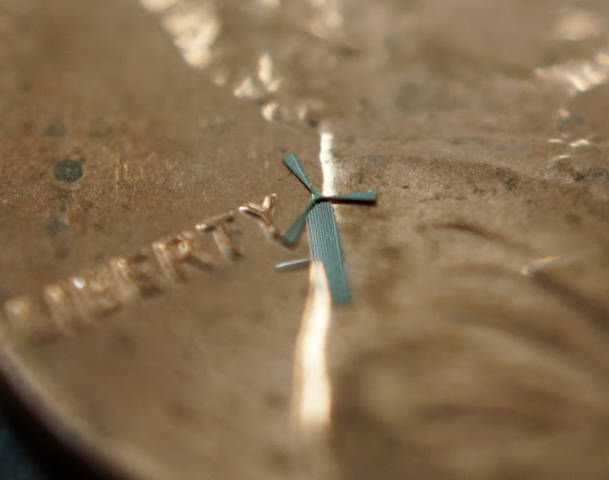
New technology could power smartphones with tiny windmills
Electronics manufacturers have been pursuing the idea of a "self-recharging" smart phone for a few years, but most of these efforts have been just chasing windmills. But by using actual windmills of tiny microscopic sizes a group of researchers at the University of Texas at Arlington thinks they've developed the self-recharging phone. Their work is promising enough that WinMEMS Technologies, a Taiwanese metallic fabrication company, has already snatched up the commercial rights, and someday we may charge our cellphones just by holding them up outdoors.
The photograph above is an actual image of one of these tiny windmills, and they do indeed work. The micro-windmills measure 1.8 millimeters at their widest point, and 10 of them could fit on a single grain of rice. Thousands of them could fit on a cell phone casing, providing a promising new green energy source for smartphones and numerous other devices.
The micro-windmills are the inventions of UT electrical engineering professor J.-C. Chiao and research associate Smitha Rao,
"It’s very gratifying to first be noticed by an international company and second to work on something like this where you can see immediately how it might be used,” said co-developer Smitha Rao. “However, I think we’ve only scratched the surface on how these micro-windmills might be used."
While consumers would surely go for wind-powered cell phones that recharge themselves, smartphone manufacturers have other incentives too. The cell phone batteries we currently dispose contain all manner of toxic chemicals that constitute hazardous waste.
The micro-windmills have been successfully tested, and they do indeed work. They're made of incredibly strong nickel alloy, and the cost of making one is virtually the same cost as making a thousand of them.
Co-developer Dr. Chiao estimates that 2,040 of the tiny windmills could fit on the back of an iPhone.
"Imagine that they can be cheaply made on the surfaces of portable electronics,” Dr. Chiao said, “so you can place them on a sleeve for your smart phone. When the phone is out of battery power, all you need to do is to put on the sleeve, wave the phone in the air for a few minutes and you can use the phone again."
The micro-windmills could also be used in larger numbers to power household energy or security. But if they can just keep our smartphone batteries from dying, these little windmills will have a lot of fans.

- Credibility

- Reach


- United States of America (91.6%)
- Thailand (1.0%)
- Pakistan (0.9%)
- India (0.9%)
- 41 other countries (4.9%)
News Stories
-
Mobiles phones powered by WIND TURBINES: 'Micro-windmills' could be fitted ...
13 January 2014 17 shares 15 View comments Forget hand-cranked chargers and solar-powered cases, the latest way to solve the ever-present problem of a dying phone battery is by using thin air. Researchers from Texas have developed a miniscule micro-... -
Now, 'micro-windmills' to power your cellphone
The windmills created by the researchers at the University of Texas Arlington (UTA) are so tiny that ten of them can fit on one grain of rice, the Verge reported...Chiao, if a hundred of them were glued onto a cell phone case and held out of the... -
Micro windmills may soon recharge your mobile phone
Tiny windmills might not be the energy crisis panacea you had in mind, but thinking outside the box will very likely get us there," it added. -
'Micro-windmills' could charge cellphones, inventors say
ET A 'micro-windmill' designed by researchers with the University of Texas at Arlington is shown on top of a penny. The device's designers say the windmills could be used in the future to charge cellphones or power homes. (University of Texas at...
Blogs
-
Researchers Develop Micro-Windmills to Recharge Cell Phones
Researchers have create micro-windmills to recharge cell phones. -
midosm | Micro-windmills may power your next smartphone
Micro-windmills may power your next smartphone. Two researchers from University of Texas Arlington have created a micro-windmill, which could be used to power our mobile electronic devices in an environmentally friendly way. Read more ... -
Tiny windmills could power future smartphones (maybe) - Liliputing
Mobile device makers have a few options for improving battery life. They can cram huge batteries into phones and tablets. They can improve the efficiency of ... Some companies already offer solar-powered smartphone cases, but fully recharging your -
World's smallest windmills to power cell phones - Gizmag
Professor J.C. Chiao and his postdoc Dr. Smitha Rao of the University of Texas at Arlington have developed a MEMS-based nickel alloy windmill so small that ... ... World's smallest windmills to power cell phones. By Brian Dodson. January 13, 2014. -
Researchers develop tiny windmills that can power your gadgets ...
Portable solar chargers aren't so out of the ordinary anymore, but minuscule windmills that can charge your phones? Now, those are something new. A.
Images
More From Allvoices
Add it to the network!
![]() Or add related content to this report
Or add related content to this report
News Stories | Images | Videos | Comments



.jpg)